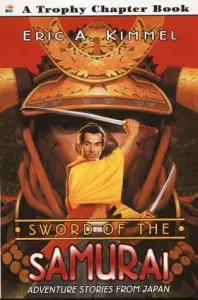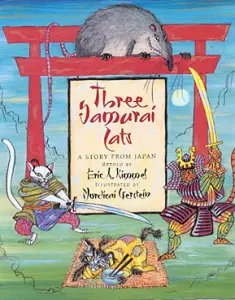 In 1997, Eric A. Kimmel, an American children’s book author, went to Japan at the invitation of a select few international schools that operate there and was so impressed with what he had seen that he decided to write a book of stories from Japan. Two years later, the product of his work was a collection of eleven stories, put together in The Sword of the Samurai, nicely illustrated by Michael Evens.
In 1997, Eric A. Kimmel, an American children’s book author, went to Japan at the invitation of a select few international schools that operate there and was so impressed with what he had seen that he decided to write a book of stories from Japan. Two years later, the product of his work was a collection of eleven stories, put together in The Sword of the Samurai, nicely illustrated by Michael Evens.
In his introduction, Knights of Japan, Eric A. Kimmel compares Europe’s medieval knights to Japan’s samurai. He concludes that both categories were driven in their endeavors by their religion (Christianity and Shintoism / Buddhism), a sense of honour, and loyalty to their masters.
The collection of stories opens with Dohaku’s Head, which relates an extraordinary incident: after losing his head in a swordfight with two ronin (masterless samurai), Dohaku returns to his home village with his head under his arm. The local doctor reattaches the head to the body. “It is often said that the samurai of recent times are nothing like the samurai of ages past. Neither are the doctors.” The story is adapted from Yamamoto Tsunetomo’s Hagakure: The Book of the Samurai, a classic written in 1716.
The Samurai and the Dragon is about Hido, a samurai who, although skilled and brave, is also extremely unlucky. When no other warlord would hire him, Hido accepts a “job” offered by the king of the Realm Below the Waters: to kill a dragon that attacks his underwater world every night when the moon is full. Using his archery skills, Hido slays the dragon and, from that day on, he is no longer considered unlucky. This story can also be found in several collections of folktales with the title The Unlucky Warrior.
The Coward is the story of a farmer who is afraid of being a soldier. When Urabe no Suetake wants to cut his head off at Lord Raiko’s order, the farmer challenges Urabe. If Urabe can’t shoot him with his bow and arrows while he is running across the field, then farmer will be free to go. Urabe, a champion archer, agrees and Lord Raiko promises the farmer his discharge from the army and a purse of gold if he survives the challenge. Needless to say, the farmer escapes unharmed and the Lord understands that the farmer was not a coward, “he was just not a very good soldier.”
In Matajuro’s Training, the readers find out the story of Yaguy Matajuro, the son of a samurai family, who showed skill with the sword but was too lazy to practice. When his father banishes him from the family, Matajuro realizes his mistakes and tries to find a sensei (a teacher) to teach him swordsmanship. No-one but Banzo, a monk at the Kumano Machi Shrine, would take him in and, after years of hard work, Matajuro realizes that “Before one can master any art, one must first learn to master oneself.”
In The Oxcart, Hidemichi, Suetake and Kintoki, three brave samurai, learn the hard way that riding in an oxcart is not an easy thing to do. Reserved to highborn women, oxcarts were beautifully decorated but very uncomfortable to ride in. Wishing to go to Murasakino to watch the precession of the Kamo festival, the three samurai friends choose to travel by oxcart, but they miss the entire fun because they get sick inside the oxcart.
The Battle of Chihaya Castle is the story of how Kusunoki Masahige defended his castle against the Hojo samurais (who were keeping emperor Go Daigo as their prisoner). Wishing for his emperor to become the actual ruler of Japan, Kusunoki, although outnumbered, rose against the Hojo clan. But, when he had no more samurai to fight and defend the castle, the women in Chihaya came up with their own plan to save the castle: stitch up dummy soldiers.
Tomoe Gozen is the story of one of the greatest samurai heroes of all time. She was a woman born in the Minamoto clan! The story goes that, as a child, Tomoe didn’t like to practice music or arrange flowers (ikebana) as all young ladies were expected to, but rather enjoyed spending time with her brothers in the dojo, training hard in martial arts. She became a skillful warrior who took part in many battles. The last one she was seen in, wielding her najinata (a Japanese pike), was when her husband and one of her brothers were killed by the army of Minamoto no Yoritomo, her husband’s cousin. Even after their death, she kept on fighting until she escaped. She was never seen again and rumors said that she gave up her weapons and became a Buddhist nun.
 The Burglar is about Minamoto no Yorinobu and his ability to detach himself from any outside influences when making a decision. When a burglar threatens the life of one of his lieutenant’s daughter, Yorinobu is able to do justice without any bloodshed. In the end, the master teaches his subjects that there is a great distinction between ‘a father’ and ‘a warrior.’
The Burglar is about Minamoto no Yorinobu and his ability to detach himself from any outside influences when making a decision. When a burglar threatens the life of one of his lieutenant’s daughter, Yorinobu is able to do justice without any bloodshed. In the end, the master teaches his subjects that there is a great distinction between ‘a father’ and ‘a warrior.’
Devil Boy is the story of Kidomaru, a famous outlaw also known as Devil Boy. For the samurais and their lords, he was a bandit, but for the farmers and the oppressed, he was a hero. Betrayed and bound with chains, Minamoto no Yorinobu, his captor, intends to kill him the morning following his capture. But, Devil Boy manages to escape and is after Lord Raiko, Yorinobu’s brother, who insulted him while he was in captivity. Wounded and fighting against five samurais, Kidomaru loses his head but is given a hero’s funeral.
By far the most profound story in the entire collection, The Ronin and the Tea Master is the story of a tea master who defeats in a duel a ronin by using his chanoyu skills. (Chanoyu is the Japanese tea ceremony, strongly inspired by the teachings of Zen Buddhism.) The story concludes that, “For just as a tree has many roots, so does a wise man have many teachers.”
No Sword is a story about Tsukahara Bokuden, a sword master who, after seeing his sons, brothers and pupils die on the battlefield, realizes that victory can also be achieved without bloodshed. Thus, he starts his own school which he calls Mutekatsu Ruy, where he teaches exactly that. One day, while crossing Lake Biwa, Bokuden is challenged to a fight by a rowdy samurai. Bokuden wins the fight without even drawing his sword: he leaves the samurai stranded on an island. “No sword.”
Many of these stories are based on actual events and some are part of Japan’s folklore and have been recoded in other books too. Thus, Matajuro’s Training, Tomoe Gozen, The Battle of Chihaya Castle, The Ronin and the Tea Master, and No Sword are based on actual accounts. They have been recorded in Samurai: The Story of a Warrior Tradition by Harry Cook. Versions of The Oxcart, Devil Boy, The Burglar, and The Coward can also be found in Legends of the Samurai by Hiroaki Sato.
Eric A. Kimmel’s The Sword of the Samurai ends with a glossary of samurai terms (which are also explained in the text or are easily understood from the context), and notes on bibliographical sources and on Japanese names. (It is good to remember that, generally, the clan or family name of the Japanese comes before the personal name.)
Eric A. Kimmel has written more than 50 children’s books, among which Hershel and the Hanukkah Goblins, The Chanukkah Guest and Three Samurai Cats: A Story from Japan. Visit the author’s website here.

